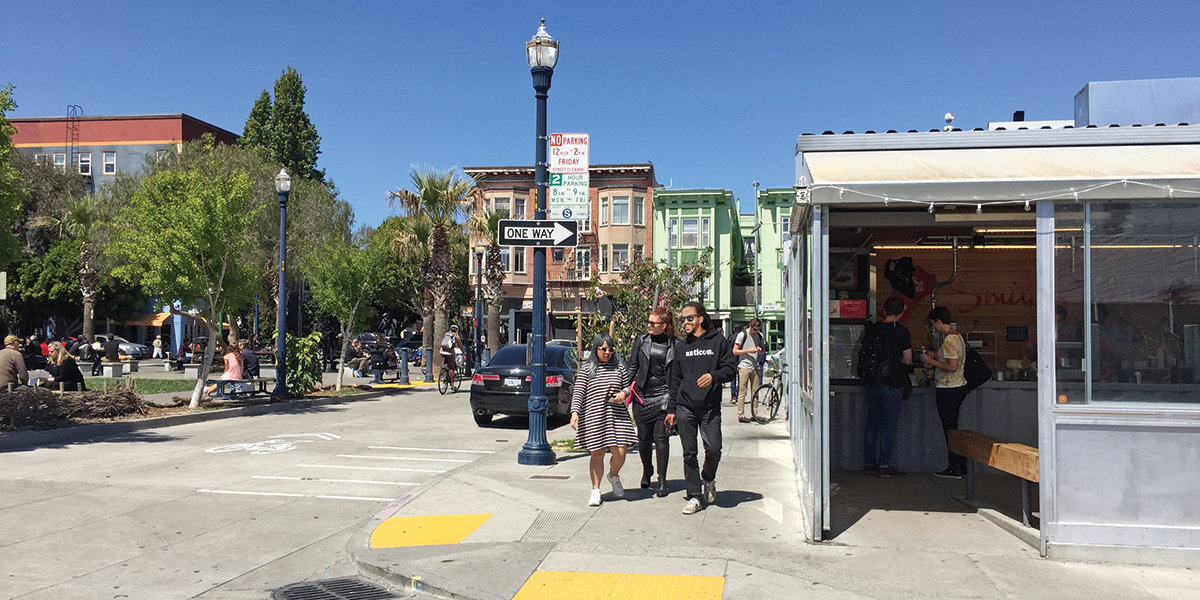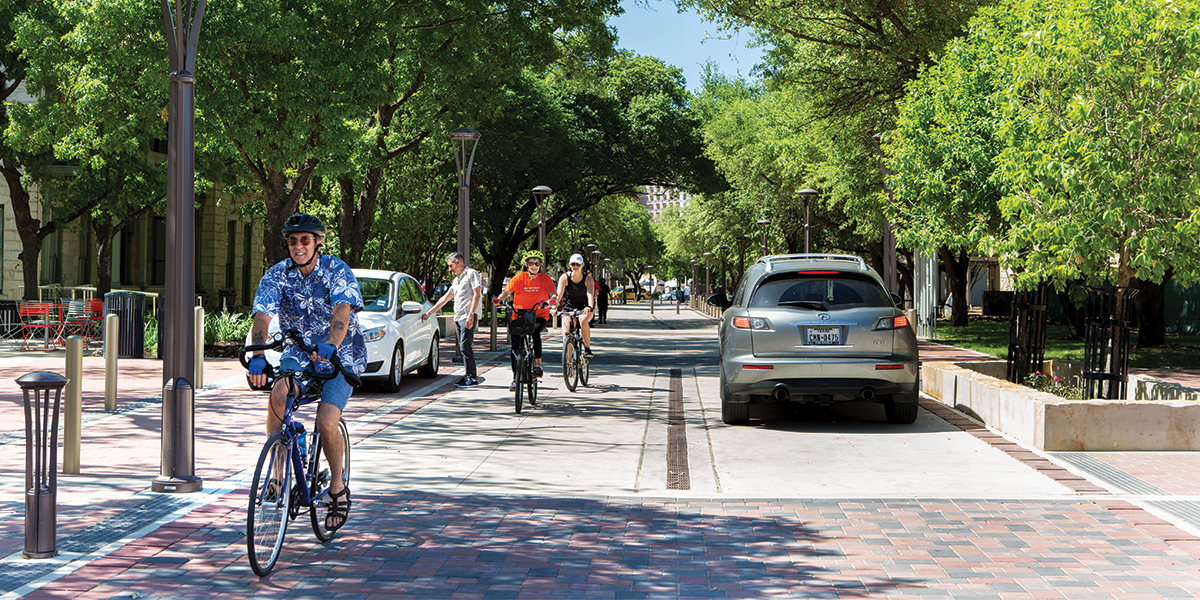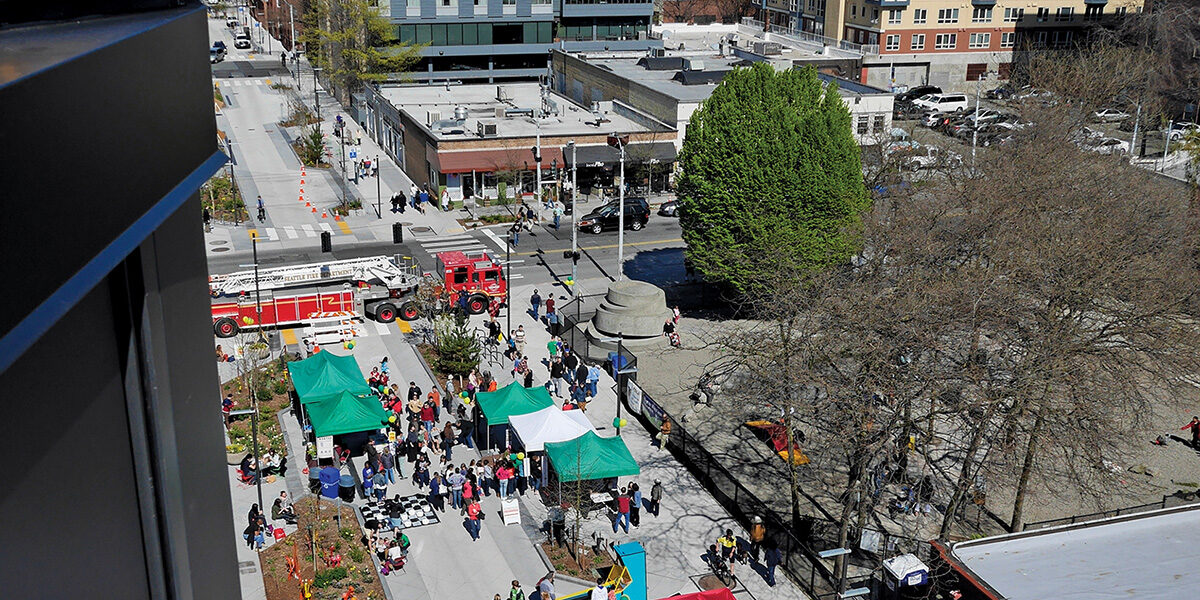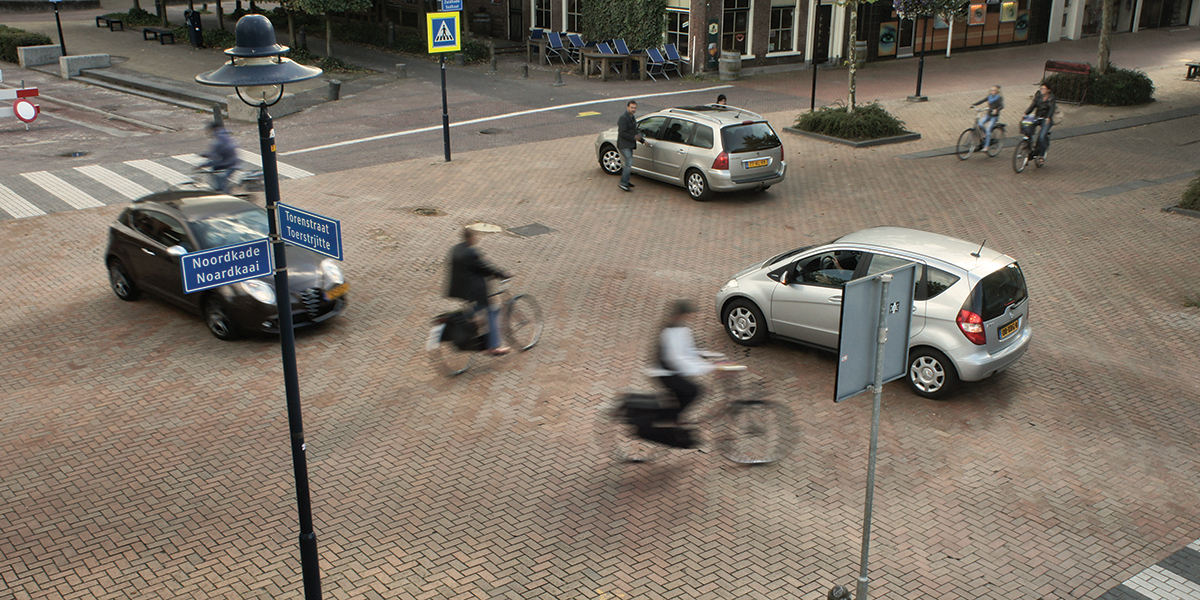We used to grow up on the street. We’d play, we’d walk to the neighbors with a casserole for the block potluck, we’d ride bikes, play games, hang out, socialize. So would our pets. Drivers knew enough to watch out for us. We all survived and thrived. We want that again. Our book, Streets Reconsidered is how we get there. In this series of excerpts we'll share some thoughts and design guidelines to get you started (Read Part 1: Streets Are for People and Part 2: Inclusive Design).
We’re stuck. Not in traffic, although we are sometimes that too. We’re stuck in how we think about mobility and finding our way on the street. But a fresh combination of physical design, technology and programming can result in streets for all types of uses, engaging all our senses, at all times of day.
Slowing traffic and eliminating curbs: Those two design interventions can shorten travel times for vehicles, increase and enhance mobility for bicyclists and pedestrians, increase commerce, and allow for many other opportunities on the street, including shared social space.
The way we build roads affects more than just the movement of vehicles. It determines how drivers behave on the street, whether pedestrians feel safe to walk and linger and what kinds of businesses and housing are built along its edges. Concentrating on the human element shifts the paradigm.
How well drivers, bicyclists and pedestrians successfully navigate through and between those organizing features depends on how easy it is to understand and interpret cues on the street. The human ability to perceive and respond to those cues relies on physical senses and the body’s ability to transmit information to processing centers in our brains.
Dutch traffic engineer Hans Monderman said: “A wide road with a lot of street signs is telling a story. It's saying, go ahead, don't worry, go as fast as you want, there's no need to pay attention to your surroundings. And that's a very dangerous message.”
Over half of the brain is devoted to vision; we rely primarily on sight to perceive the world around us. But, the immense amount of visual information available to us is overwhelming. We’ve adapted to this onslaught by what we take in. For example, when driving down a street, a driver will scan the available paths, signage and markings, glancing at specific points for less than two-tenths of a second before moving on to the next point. The more separate pieces of information a driver sees and needs to process, the less legible the street can be—and the longer it takes to find and act on the information that’s needed to navigate successfully.
People don’t simply need more information on the street to help them navigate. They need information that is tied to more senses or, sometimes, they need no information at all. Traditional traffic calming measure add physical elements like bulb outs or speed bumps, but they still “communicate” that the pavement is for cars and sidewalks are for pedestrians, making signs and other markings a necessity for tell people what to do.
By removing signage and artificial barriers such as curbs, lines and sidewalks, we force drivers to rely on their own perceptions of the street. “Psychological traffic calming” relies on social and cultural norms rather than signs and markings to moderate human behavior. For example, adding irregular vertical elements such as trees or visually complex material such as flowerbeds or café tables close to the street sends cues that this is a place where there are pedestrians. Interrupting sight lines to shorten the view adds uncertainty about what’s ahead, making drivers more careful. And eliminating sidewalks, making them flush with the street with different pavement treatments, blurs the line between vehicle and pedestrian space, signaling drivers to slow down.
Why Change the Street?
Infrastructure doesn’t need to be built with massive amounts of concrete that will last 100 years. Paint and other temporary design elements can be more effective and far cheaper than pouring concrete. Streets don’t need to have permanent speed limits; dynamic traffic controls and programmable speed signs allow speeds to change to improve traffic flow as needed. Travel lanes and parking lanes don’t need to be permanently assigned; smart studs, indicator lights, temporary bollards and travel gates can change lane uses and even travel direction during the day or on different days of the week. Parking policies don’t have to disrupt the urban fabric; limits on parking can actually increase commerce. Bicycles don’t have to be squeezed and forced to dodge car doors; narrowing vehicle travel lanes through restriping creates more space for bicycles. And pedestrians don’t have to be relegated to the sidewalk only; shared space can help all users navigate.
Not all streets are suitable for all uses. Parkways, expressways and highways are clearly devoted to fast-moving vehicular traffic. But main streets, local streets, and even boulevards and avenues can be flexible, functioning differently at different times of day or on different days of the week, providing many more community benefits.
This is the third in an 8-part series excerpted from Iacofano’s and Malhotra’s new book, Streets Reconsidered: Inclusive Design for the Public Realm. Purchase the book using the promo code MIG19 for a 20% discount through Routledge (with free shipping!). Coming next month, Part 4: Designing Social Streets
Daniel Iacofano, PhD., FAICP, FASLA, has over 30 years of experience in community-based urban planning and design and has consulted with communities worldwide.
Mukul Malhotra, one of the creators of re:Streets, works on the ground with cities and communities to sustainably redevelop streets and improve the built environment for everyone.




